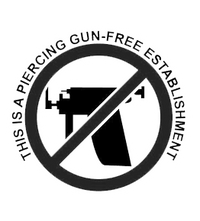Piercing info:
Materials:
All of our piercings are pierced with a sterile implant grade titanium (Ti-6Al-4V-ELI / ASTM-F136 or Ti-6Al-7Nb / ASTM-F1295) that is compliant with the national regulations for initial piercing jewelry under annex XVII of the European REACH regulation and the Association of Professional Piercers (APP). We also pierce with 14 and 18 karat solid gold on request.
We always pierce initial piercings with a bar instead of a ring (except for the septum, daith and some genital piercings) to prevent friction during the first stage of healing. After healing it's allowed to replace the initial jewelry for a ring.
Our implant grade titanium jewelry is manufactured with the highest care comliant to DFARS (Defense Federal Acquisition Regulation Supplement). Piece by piece the jewelry is hand polished to guarantee a mirror smooth finish to avoid micro-nicks which can lead to irritation or a source of bacteria.
Jewelry quality is a really important factor in good healing. In the picture below you can clearly see the difference between good quality implant grade jewelry and cheap externally threaded garbage jewelry:
Mill certificates that prove that our materials are manufactured compliant to the ASTM-F136 or ASTM-F1295 standard (American Society for Testing and Materials international) are available at the shop or by clicking here. A piercing is an open wound, so it needs implant grade titanium, 14-18K gold, niobium, platinum or glass to properly heal. So never go for titanium or any other type of steel with no data about where and how it's manufactured or the composition of materials is unknown, also don’t wear jewelry that have a PVD-coating, are gold plated, vermeil gold or contain cadmium or nickel. Coatings can break and get loose and most materials under these coatings are not compliant to piercing jewelry standards.
With our implant grade jewelry it's safe to have certain medical examinations like MRI or X-rays. Except when the piercing is directly in the area of examination. If you would like information to take to your doctor please contact us and we will provide you with all the info. Most doctors will allow the piercing to stay in when they know it's a safe material that is non-ferromagnetic.
In the piercing industry you hear a lot about stainless steel (also known as surgical steel). This, however, is in almost all of the cases not a good material to be pierced with, unless they are compliant to a standard called ASTM-F138. When you are looking for jewelry (online or in physical shops) and they advertise with 'surgical steel' it's almost always assumable that they are not compliant to the ASTM-F138. These inspections cost the factories a lot and require specific analyses and finishes to their product, so if their stainless steel is compliant to this standard, they would most definitely advertise with it to be a ASTM-F138 type of jewelry. That's why we use more biocompatible types of jewelry, like implant grade titanium.
Method of working:
It all starts with you. It’s important that you start prepping your body before the piercing procedure. The best way to do that is by getting enough rest the night before the appoinment, don’t drink alcohol in the 24 hours prior to the procedure and eat and drink well before you come to the studio. A good prepared body is likely to experience less pain when getting pierced.
Prior to the piercing process we always check if you have the anatomy for the piercing that you wish to get done. Also we check what would be the best spot esthetically for piercing placement. Your own preference is also checked together with you to get the best result. We start with a thorough cleaning of the skin and then place a mark using a sterile marking instrument for single use. After you've checked the mark you can lay down on the client chair. We then do a second prep using a disinfection agent while we also unwrap all sterile instruments and jewelry. When you are ready for the actual piercing we switch from examination gloves to sterile gloves and start piercing the skin. When it's all finished we explain the aftercare again and ask if there are still any questions about the piercing.
You will be pierced by Mike, the owner of Shot of Ink and member of the APP & APP Benelux (Association of Professional Piercers). He’s a professional piercing artist who started in 2007. Mike has all the qualifications needed to be piercing you safely such as First aid + CPR, Blood Borne Pathogens (BBP) and Infection Prevention & Control (IPC).
There are some body parts that we don’t pierce, this could be because of multiple reasons, most importantly whether the piercing is medically a high risk factor or not. Examples of piercings with high risks are cheek piercings, smiley piercing, horizontal piercing in the tip of the tongue (snake eyes) or surface piercings on the upper side of the tongue. These piercings can cause permanent damage to the body itself or it’s functions. Every piercer with respect for their profession will refuse to pierce these piercings.
We will not use piercing guns in our studio. The use of piercing guns is always a bad choice, because the jewelry is made of poor quality materials. Also it causes way more trauma to the tissue than necessary. Piercing guns can not be sterilized in an autoclave and can also not be properly disinfected, which make them a source of bloodborne pathogens and bacteria. Also the jewelry in the piercing guns are one size fits all, and no ear is the same, so we need to choose the jewelry that is the proper size for your ear.
Possibilities:
Would you like the jewelry in another color? Or even multiple colors in one? That’s also possible with our titanium jewelry. We can anodize them for you. Anodizing is an electrochemical process which gives a material such as titanium a decorative color, which is very durable and corrosion resistant. After anodizing the color is fully integrated in the material, so it can not chip or peel, in comparison to PVD coatings.
If you've had a piercing before and want to get the same spot re-pierced that's almost always possible, but the jewelry has to be removed for the duration of 3 months before getting it re-pierced.
To downsize or change your jewelry you can make an appointment. All piercings bought from our studio will be inserted for you free of charge. If you buy jewelry from other reputable piercers or online shops we ask you to bring a receipt or a certificate so we can verify that the jewelry is safe for long term wearing.
Warranty:
All of our piercing jewelry come with a lifetime warranty on manufacturing defects, so when a gemstone gets lost or a pin breaks we will replace the item for you at no charge so you can enjoy your new piercing jewelry forever without having to worry about it. This warranty is only on manufacturing defects, not if you are losing a jewelry top or post. To benefit from the lifetime warranty you always have to bring the jewelry top or post back to the studio so we can replace it for you.
Risks and aftercare:
- Give the piercing as much rest as possible. Don't touch it, hands are always dirty and full of micro organisms. Don't twist the jewelry, the titanium that is used for your initial piercing is high polished so it will never stick to the skin.
- Avoid pressure or friction during the whole healing process. This also means no sleeping on the piercing. In the case of ear piercings use a travel pillow to make sure the piercing isn’t exposed to pressure. Also don’t hold your phone to healing ear piercings due to the fact that a phone contains a lot of micro organisms.
Pressure and friction during healing can lead to irritation bumps and shifting of the jewelry.
- Don't touch scabs, only touch scabs that are loose by itself, use a clean paper towel to remove these scabs.
- Make sure you always wear high end jewelry, also after initial healing period. Cheap and badly made jewelry will damage the piercing. When you buy new titanium jewelry somewhere please always ask for the mill certificates of the jewelry. If that’s not available it’s most likely not safe to wear in your body.
- Only listen to advise from your piercer or GP. Only use products that are suitable for treating fresh piercings. We sell NeilMed fine piercing mist, this sterile saline stays sterile during usage and therefor is the best option for healing your piercing. For oral piercings we advise general hygiëne and an alcohol free mouthwash.
- Some piercings tend to swell, the jewelry that has been placed in it while piercing you is sometimes too long, but in case of swelling it's necessary. When you experience swelling with oral piercings it's best to cool it down by putting a little bit of ice in your mouth. This reduces the swelling and possible discomfort. After the initial healing stage you can get the jewelry downsized.
- Do not use numbing cremes before your piercing appointment. These cremes affect the skin and bloodflow on the area which can result in crooked piercings once the creme has worn off. If you come in for your appointment with numbing creme on the piercing site we will not perform the piercing.
All information about the risks of piercings: click here.
All information about the aftercare of piercings: click here.
Legislation:
We only do piercings following the national laws regarding age limits; from 12 years and up under supervision of 1 elder or legal guardian. From 16 years and up without supervision (except nipples and genitals, this is only possible from 18 years and up).
When getting pierced we always ask you to fill in the mandatory consent form. This form will be printed for you to fill in upon your arrival at the shop.
Always bring a valid ID, and in the case that you need supervision also the elder or legal guardian needs to bring their ID. Accepted methods are EU-ID card, passport and drivers license.
Price list:
The total price of your piercing is determined by the price of the jewelry that you choose plus the piercing fee to perform the piercing. Every piece in our studio has its own price, so it is difficult to give a price total online without knowing which piece of jewelry you would like. Below are the starting prices of the jewelry for each piercing.
Ear piercing: €35,- / jewelry starting at €27,50,-
Nose piercing: €35,- / jewelry starting at €27,50,-
Eyebrow piercing: €35,- / jewelry starting at €37,50,-
Lip piercing: €35,- / jewelry starting at €27,50,-
Navel piercing: €35,- / jewelry starting at €75,-
Nipple piercing: €35,- / jewelry starting at €40,-
Genital piercing: €35,- / jewelry starting at €35,-
Tongue piercing: €35,- / jewelry starting at €40,-
Industrial piercing: €55,- / jewelry starting at €40,-
When you get 2 piercings done in a single appointment the piercing fee will be €60,- in total. (Jewelry not included)
When you get 3 piercings done in a single appointment the piercing fee will be €85,- in total. (Jewelry not included)
We recommend the Neilmed piercing aftercare for a gentle healing. This sterile saline is recommended for all of your healing piercings. Price per bottle of 177ml is €12,50.
Changing jewelry bought at our studio is free of charge. Changing jewelry from other reputable piercers costs 10€ (Only sealed and with correct mill certificates or any proof that they are APP certified materials, without proof of them being implant grade materials we will not use it to change your piercing jewelry).
Healing:
Down below you will find a list of healing periods of the piercings. The healing period is just an indication, every persons heals at a different pace.
Nose: 6 tot 9 months
Ear cartilage: 6-9 months
Ear lobes: 6-9 weeks
Ear stretching: 4-6 weeks
Industrial (cartilage): 8-12 months
Eyebrow: 6-8 weeks
Tongue: 4-8 weeks (changing the initial longer jewelry is possible after a minimum of 10 days)
Lip: 7-9 weeks
Nipple: 3-9 months
Genitals: between 6 weeks and 9 months (depending on which piercing)
Surface: 8-12 months
Belly button: 6-9 months
Attention: Shop visits are only possible on appointment! We don’t do walk ins.
For piercing appointments click here


